Vladimir Nabokov is one of the great twentieth-century writers. He wrote of himself: “I was born in Russia and went to university in England, then lived in Germany for twenty years before emigrating to the United States.” The first half of his oeuvre was written in Russian; then he switched briefly to French, and then permanently to English. He also spent a third period of exile living in Geneva, and translating his earlier works from Russian into English.
Nabokov loves word-play, stories that pose riddles, and games which keep readers guessing. Above all, he loves jokes. He produces witty and intellectual writing – and yet persistently draws our attention to moments of tenderness and neglected sadness in life. It is lyric, poetic writing, in the best sense of these terms.
Beginners should start with some of the short stories or the early novels, before tackling the challenges of his later work. Be prepared for black humour and unashamed tenderness – often on the same page. And be sure to keep a dictionary on hand.
 Lolita (1955) is without doubt Nabokov’s masterpiece – a tour de force of fun and games in both character, plot, and linguistic artistry. And yet its overt subject is something now considered quite dangerous – paedophilia. A sophisticated European college professor goes on a sexual joy ride around the USA with his teenage step-daughter. He evades the law, but drives deeper and deeper into a moral Sargasso, and the end is a tragedy for all concerned. There are wonderful evocations of middle America, terrific sub-plots, and language games with deeply embedded clues on every page. You will probably need to read it more than once to work out what is going on, and each reading will reveal further depths.
Lolita (1955) is without doubt Nabokov’s masterpiece – a tour de force of fun and games in both character, plot, and linguistic artistry. And yet its overt subject is something now considered quite dangerous – paedophilia. A sophisticated European college professor goes on a sexual joy ride around the USA with his teenage step-daughter. He evades the law, but drives deeper and deeper into a moral Sargasso, and the end is a tragedy for all concerned. There are wonderful evocations of middle America, terrific sub-plots, and language games with deeply embedded clues on every page. You will probably need to read it more than once to work out what is going on, and each reading will reveal further depths.
Lolita – a tutorial and study guide
Lolita – buy the book at Amazon UK
Lolita – buy the book at Amazon US
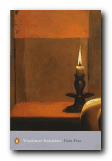 Pale Fire is a very clever artistic joke. It’s a book in two parts – the first a long poem (quite readable) written by an American poet who we are encouraged to think of as someone like Robert Frost. The second half is a series of footnoted commentaries on the text written by his neighbour, friend, and editor. But as we read on the explanation begins to take over the poem itself, we begin to doubt the reliability – and ultimately the sanity – of the editor, and we end up suspended in a nether-world, half way between life and illusion. It’s a brilliantly funny parody of the scholarly ‘method’ – written around the same time that Nabokov was himself writing an extensive commentary to his translation of Pushkin’s Eugene Onegin.
Pale Fire is a very clever artistic joke. It’s a book in two parts – the first a long poem (quite readable) written by an American poet who we are encouraged to think of as someone like Robert Frost. The second half is a series of footnoted commentaries on the text written by his neighbour, friend, and editor. But as we read on the explanation begins to take over the poem itself, we begin to doubt the reliability – and ultimately the sanity – of the editor, and we end up suspended in a nether-world, half way between life and illusion. It’s a brilliantly funny parody of the scholarly ‘method’ – written around the same time that Nabokov was himself writing an extensive commentary to his translation of Pushkin’s Eugene Onegin.
Pale Fire – a tutorial and study guide
Pale Fire – buy the book at Amazon UK
Pale Fire – buy the book at Amazon US
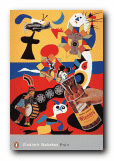 Pnin is one of his most popular short novels. It deals with the culture clash and catalogue of misunderstandings which occur when a Russian professor of literature arrives on an American university campus. Like many of Nabokov’s novels, the subject matter mirrors his life – but without ever descending into cheap autobiography. This is a witty and tender account of one form of naivete trying to come to terms with another. This particular novel has always been very popular with the general reading public – probably because it does not contain any of the dark and often gruesome humour that pervades much of Nabokov’s other work.
Pnin is one of his most popular short novels. It deals with the culture clash and catalogue of misunderstandings which occur when a Russian professor of literature arrives on an American university campus. Like many of Nabokov’s novels, the subject matter mirrors his life – but without ever descending into cheap autobiography. This is a witty and tender account of one form of naivete trying to come to terms with another. This particular novel has always been very popular with the general reading public – probably because it does not contain any of the dark and often gruesome humour that pervades much of Nabokov’s other work.
Pnin – a tutorial and study guide
Pnin – buy the book at Amazon UK
Pnin – buy the book at Amazon US
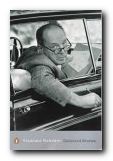 Collected Stories Nabokov is also a master of the short story form, and like many writers he tried some of his literary experiments there first, before giving them wider reign in his novels. This collection of sixty-five complete stories is drawn from his entire working life. They range from the early meditations on love, loss, and memory, through to the later technical experiments, with unreliable story-tellers and the games of literary hide-and-seek. All of them are characterised by a stunning command of language, rich imagery, and a powerful lyrical inventiveness.
Collected Stories Nabokov is also a master of the short story form, and like many writers he tried some of his literary experiments there first, before giving them wider reign in his novels. This collection of sixty-five complete stories is drawn from his entire working life. They range from the early meditations on love, loss, and memory, through to the later technical experiments, with unreliable story-tellers and the games of literary hide-and-seek. All of them are characterised by a stunning command of language, rich imagery, and a powerful lyrical inventiveness.
Buy the book at Amazon UK
Buy the book at Amazon US
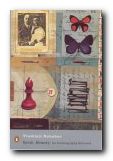 Speak Memory is supposed to be an autobiography, but if you are looking for frank confessions and concrete details, you will be disappointed. Nabokov was almost pathologically private, and he argued consistently that readers should not look into writer’s private lives. This ‘memoir’ covers Nabokov’s first forty years, up to his departure from Europe for America at the outset of World War II. The ostensible subject-matter is his emergence as a writer, his early loves and his marriage, his passion for butterflies and his lost homeland. But what he really offers is a series of meditations on human experience, the passage of time, and how the magic of art is able to transcend and encapsulate both.
Speak Memory is supposed to be an autobiography, but if you are looking for frank confessions and concrete details, you will be disappointed. Nabokov was almost pathologically private, and he argued consistently that readers should not look into writer’s private lives. This ‘memoir’ covers Nabokov’s first forty years, up to his departure from Europe for America at the outset of World War II. The ostensible subject-matter is his emergence as a writer, his early loves and his marriage, his passion for butterflies and his lost homeland. But what he really offers is a series of meditations on human experience, the passage of time, and how the magic of art is able to transcend and encapsulate both.
Buy the book at Amazon UK
Buy the book at Amazon US
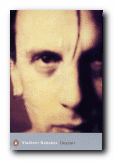 Despair – is an early ‘Berlin’ novel which deals with the literary figure of ‘the double’. Chocolate manufacturer Herman Herman (see the point?) is being cuckolded by his vulgar brother-in-law and his sluttish wife. He meets a man who he believes to be his exact double, and plans a fake suicide to escape his torments. Everything goes horribly wrong, in a way which is simultaneously grotesque, amusing, and rather sad. All of this is typical of the way in which Nabokov manages to blend black humour with a lyrical prose style.
Despair – is an early ‘Berlin’ novel which deals with the literary figure of ‘the double’. Chocolate manufacturer Herman Herman (see the point?) is being cuckolded by his vulgar brother-in-law and his sluttish wife. He meets a man who he believes to be his exact double, and plans a fake suicide to escape his torments. Everything goes horribly wrong, in a way which is simultaneously grotesque, amusing, and rather sad. All of this is typical of the way in which Nabokov manages to blend black humour with a lyrical prose style.
Despair – a tutorial and study guide
Despair – buy the book at Amazon UK
Despair – buy the book at Amazon US
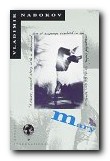 Mary (1923) is his first novel, in which he evokes the raptures of youthful pleasures, and the discovery of passion and loss. His lyrical prose records a young Russian exile’s recollections of his first love affair. But the woman in question clearly symbolises his relationship with Russia. Nabokov is also good at a creating a marvellous sense of awe in contemplating the quiet aesthetic pleasures in everyday events and special moments of being.
Mary (1923) is his first novel, in which he evokes the raptures of youthful pleasures, and the discovery of passion and loss. His lyrical prose records a young Russian exile’s recollections of his first love affair. But the woman in question clearly symbolises his relationship with Russia. Nabokov is also good at a creating a marvellous sense of awe in contemplating the quiet aesthetic pleasures in everyday events and special moments of being.
Mary – a tutorial and study guide
Mary – buy the book at Amazon UK
Mary – buy the book at Amazon US
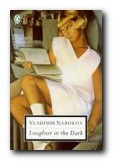 Laughter in the Dark and King, Queen, Knave show a much darker side to his nature, with its focus on adultery and deception. These traits are taken to an uncomfortable extreme in Laughter in the Dark (1932) which plots the downfall of a man who runs off with a young girl who, when he is rendered blind in a car accident, secretly moves her lover in to live under the same roof. The pair of them torment the protagonist in a particularly gruesome fashion – a theme Nabokov was to explore twenty years later in Lolita.
Laughter in the Dark and King, Queen, Knave show a much darker side to his nature, with its focus on adultery and deception. These traits are taken to an uncomfortable extreme in Laughter in the Dark (1932) which plots the downfall of a man who runs off with a young girl who, when he is rendered blind in a car accident, secretly moves her lover in to live under the same roof. The pair of them torment the protagonist in a particularly gruesome fashion – a theme Nabokov was to explore twenty years later in Lolita.
Laughter in the Dark – a tutorial and study guide
Laughter in the Dark – buy the book at Amazon UK
Laughter in the Dark – buy the book at Amazon US
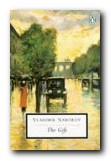 The Gift (1936) is generally held to be the greatest of his Russian novels. It deals with the ironies and agonies of exile. It is the last of the novels Nabokov wrote in his native Russian and the crowning achievement of that period in his literary career. It’s also his ode to Russian literature, evoking the works of Pushkin, Gogol, and others in the course of its narrative: the story of Fyodor Godunov-Cherdyntsev, an impoverished émigré poet living in Berlin, who dreams of the book he will someday write – a book very much like The Gift itself. The novel also includes a deeply felt fictionalisation of the murder of Nabokov’s own father in 1922 whilst he was attempting to stop a political assassination.
The Gift (1936) is generally held to be the greatest of his Russian novels. It deals with the ironies and agonies of exile. It is the last of the novels Nabokov wrote in his native Russian and the crowning achievement of that period in his literary career. It’s also his ode to Russian literature, evoking the works of Pushkin, Gogol, and others in the course of its narrative: the story of Fyodor Godunov-Cherdyntsev, an impoverished émigré poet living in Berlin, who dreams of the book he will someday write – a book very much like The Gift itself. The novel also includes a deeply felt fictionalisation of the murder of Nabokov’s own father in 1922 whilst he was attempting to stop a political assassination.
Buy the book at Amazon UK
Buy the book at Amazon US
© Roy Johnson 2009
More on Vladimir Nabokov
More on literary studies
Nabokov’s Complete Short Stories